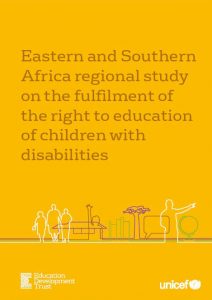 3 November 2016: My research on gender and children with disabilities conducted in Rwanda in 2015, has just been cited by UNICEF and the Education Development Trust in their Eastern and Southern Africa regional study on the fulfilment of the right to education of children with disabilities.
3 November 2016: My research on gender and children with disabilities conducted in Rwanda in 2015, has just been cited by UNICEF and the Education Development Trust in their Eastern and Southern Africa regional study on the fulfilment of the right to education of children with disabilities.
The original research was conducted as part of a programme evaluation for Chance for Childhood (now known as Chance for Childhood with Street Child Africa).
Here is the relevant extract from the report:
Demand Side Conditions
The regional study looked for evidence that commented on the demand-side conditions that can support the fulfilment of the right to education for children with disabilities. Demand-side conditions include social norms, stakeholder attitudes, encouragement for families to engage with educational opportunities for children with disabilities, for example…
… In Rwanda, cultural attitudes are also cited as impediments to the inclusion and enrolment of children with disabilities. Attitudes are embedded in cultural and religious beliefs, and stakeholders at all levels say it remains culturally difficult for a parent to admit they have a child with disabilities, for example because disability is seen as a curse from God. Officials mentioned that there is no incentive for schools to accept children with disabilities, or any penalty if they do not.
Research in Rwanda for Chance for Childhood reveals that the problem of stigmatisation is internalised by children with disabilities, manifesting itself as a lack of self-belief and hope in terms of the future. This first arises from the negative attitudes of parents towards their children: “Children are stigmatised from deep inside their families”. As one school teacher noted “I tell children off for name calling a pupil with disabilities and they answer by saying that the child’s parents call them the same thing, so it must be OK.” The power of parental advocacy was noted as significant; “children are literally moved into the home from living in pig sheds”.
Compounded stigma
Children with disabilities often suffer from layers of discrimination. For example, in Rwanda, parents are often unwilling to spend money on the uniform for a child with a disability as they believe it is a bad investment, as the child probably will not succeed at school, or the family may be too poor to afford uniform. The lack of school uniform for children with disabilities means they may be denied entry to school, or if allowed to attend without a uniform, this further marks their exclusion and further compounds their stigmatisation.
One eight year old boy encountered during research in Rwanda was left handed but the teacher forced him to use his right hand even though it was physically impaired, as there are entrenched attitudes that the right hand is correct for writing, and left hand writers are therefore stigmatised. Not only is the boy facing two types of stigma, but being forced to write with his right hand was further inhibiting his education because he found it so difficult to write.
Gender implications of stigmatisation
Research from Rwanda also revealed that where there is gender inequality in society, girls with disabilities are doubly stigmatised; “They have the double stigma of being a girl and disabled”. This stigma can be caused by a perceived lack of marriage prospects. Men with disabilities simply have to earn money to become an attractive marriage prospect. However for women with a disability, earning money is said to make no difference, as she is still seen to be impaired for childbearing and domestic duties.
The mother of a girl, age 13, with a visual impairment, noted: “Disabled girls are very shy compared to disabled boys and need special care. They feel very inferior and are withdrawn”. The Chance for Childhood Education, Equality and Empowerment (EEE) Project in Rwanda is training Learning Support Assistants (LSAs) for children with disabilities to recognise that disability has a profoundly more negative effect on girls than boys in a learning environment. This is mainly due to lower self-esteem which affects girls’ confidence at a very basic level, even with support.
Other issues unique to girls with disabilities Communication impaired girls are more likely to be subjected to sexual assault and defilement than a girl without a disability and have little recourse to justice due to not being able to identify the perpetrator or bear witness to the crime. In Rwanda, there is little or no training in this area: the community, police, judiciary all need sensitising on this issue.
Sexuality education is particularly important for girls with communication impairments, as many messages are not absorbed through daily communication, as they are for girls with unimpaired hearing. VSO in Rwanda recommended that communications impaired girls should have special sexuality education awareness in some form. The risk of pregnancy means that girls with disabilities are seen as a liability in terms of being cared for by NGOs helping children with disabilities into education, and so boys can sometimes be the main targets of help.
Read the full report Eastern and Southern Africa regional study on the fulfilment of the right to education of children with disabilities.
